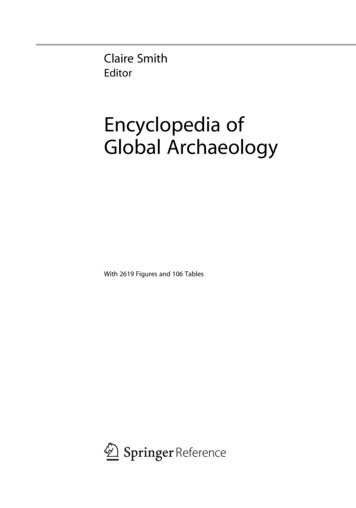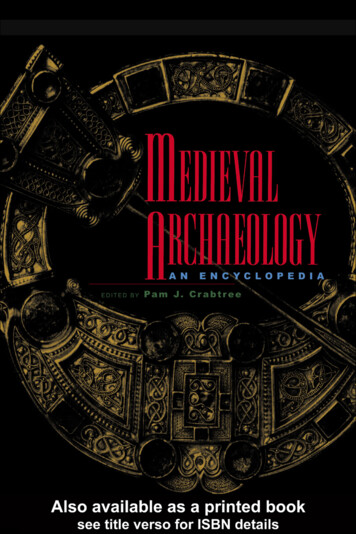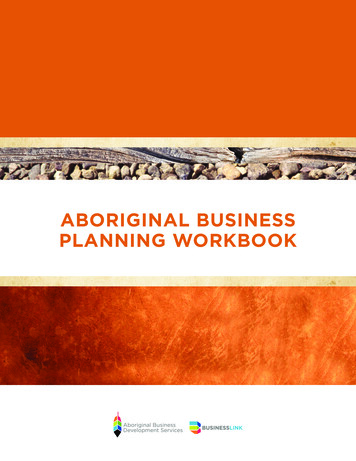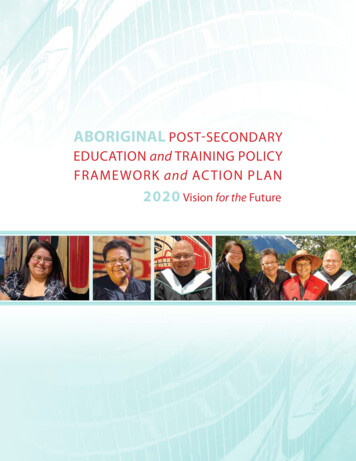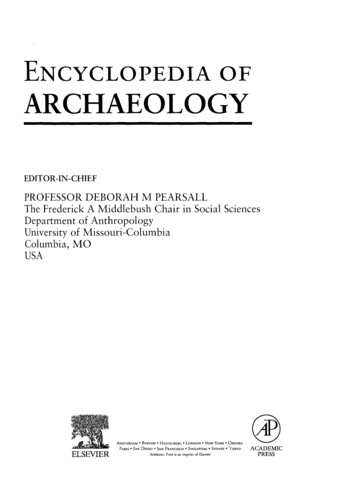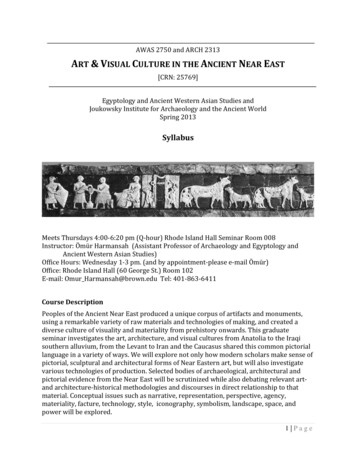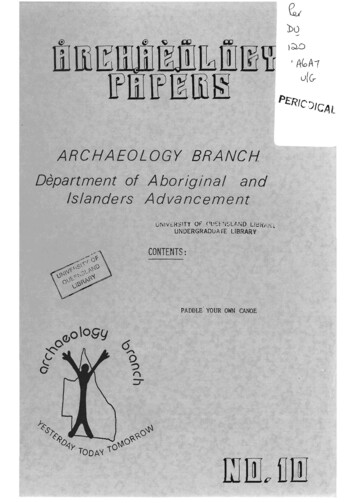
Transcription
ARCHAEOLOGY BRANCHDepartment of Aboriginal andIslanders AdvancementUNIVC.HSITY OF C'l! f 'J U'.NO LIBR. -. UNDERGRADI.JAfE LIBRARYCONTENTS:PADDLE- YOUR OWN CANOE
PER10DICA[·-·:' '"J.l' ERSITY OF QUEENSJ-,. AT7V!\""'. r· . . ., . -·)1:"\---t· ·r;a,.oll.-· I' " - ' 1-J. - -- · .-· -Archaeology Bl'aMh,Derxzrtment of Aboriginal and Islanders Adva:rzoerren.t,P.O. Box 69 Foratitud2 VaUey Q. 4006. Phone 224 5?15.Ranger HeadquaratePs: Mt. Isa - P.O. Box 309, - lea.CairrtE - 6 Abbott Street, Cail"n.8.Roakhfznrptor. ·· J5 William Street, Rockhampton.Inju.JW - CO'POnation .c-treet, TnjtlYU2.Laura - C/- Poet Office, Laura.ACKNOWLEDGEMENTS:This article was prepared from a scriptsupplied by M . Barry Struber, HonoraryWarden. Hareeba.
{.)I c.1.: !::[i·j :, :. /. ;. ';:: c·::::';Rt,;)lJ.:H u ;:. :.- .: t; .··. ) -:. : r y:'i'.
PADDLE YOliK 0 1 N CANOEWatercraft played a very important role in the daily life of many of theAboriginal tribes of Aus t l·al in, as they moved across the terrai n '"i th theseasons, searching for food.T:te first Aborigines "to arrive on Australia's shores 1wuld have usea raftsor canoes to journey from the land of their origin. The map below shows theareas to the north of Australia from where it is believed the Aborigines came.(Fig. 1) They started moving south approximately 60,000 to 70,000 years ago "'henthe seas \ Jere lower during the Ice Ages (the Pleistocene). At that time, there\vas a land bridge between Papua Ne1.; Guinea and northern Australia and accessto the southern continent was relatively easy.The Aborigine s continued to use canoes after their arrival in Australia asthey spread to other parts of the continent. Different types of canoes weredeveloped, dependent upon the materials a vailab lc and the use to which thecanoes \\'ere put.TI:roughout the continent there were many tYPes of lvatercraft , from th e sin g lelog to the fast moving sea-\.;orthy outri gger canoes. The latter were us e e! onlyin what is now called North Queensland , and were probably a later introductionfrom Papua-New Guinea.;·,\]., I( a f t er Une s co 1 973 )1
Logs were mainly used for the crossing of streams and to journey from themainland to nearby islands. To manufacture this simple ftmctional craft thetrunk of some very light tree was cut to approximately two metres in length.In the water, it easily supported a man who stretched hirnsel f along it. Hewas then able to paddle with one hand and carry his spears etc., in the other.Occasionally bundles of ti-tree were tied together and ti-tree bark laid ontop as a stable platform. All the belongings, infants and the younger childrenunable to swim were placed on top, as the adults swam beside. This methodwas used to cross short distances.(Fig. 2) For longer j oumeys of up to8km between islands, logs of 3 to 5 metres long were used with several personsriding on each one.FIG 2------------------------- ---------·-(after Roth, W.E. 1910)Larger log rafts were used in various parts of the east coast of Australia whencrossing wider tracts of water. They were made by tying a number of logstogether using native rope, lawyer cane or sui table vine. These rafts werepropelled by a long pole or by hand paddles made of bark or wood. Small piecesof timber were placed across one end and on it clay or sand was heaped so thata fire could be kept smouldering. These rafts were used for fishing as well asfor crossing larger rivers, lakes, bays, etc.The simplest type of canoe made by the first Austral i a.rs cons is ted of a 1 argesheet of bark s tripped from a suit able tree, e.g. river red gum. This oftennecessitated climbing to a considerable height to obtain suitable bark. Thebark had to be removed at a time when the sap was flowing freely in the Springtime for some trees and during the wet season for others. At this time, thebe1rk 'vas much easier to remove in one piece than at other times of the year"2
Using a stone axe, the bark was cut to the required length and the strip wasthen carefully removed using pieces of stick an d s tones as wedges. Vine orrope was tied around the tree so that the bark would no t f ll an d be damaged.When the bi.i1·, was free it was lowered carefully to the ground with these ropes.Along the Murray River, on removal of a suitable length of bark (Fig" 3) thetwo ends were pointed and the b.1.rk manipulated while still fresh and pli ab le, toform a very crude canoe. Strong sti;:k 11 spl'caders" were inserted during thedrying process. This was the simplest form o f the bark canoe and was onlysuitable for use in the protected inland river systems. It was used for crossingrivers and for L shing the many inland lakes and waterways. (Edwards, R. 19 72)FIG 3(a f ter Edwar ds , R.1972)A more complex type of c an0e (Fig . 4) was made from cylinders of bark from threemetres to five metres l on g. Afte r the bark h ad been removed from the tree theouter surface was stripped an d the ends thi nned in prep:-· -:-ation for tying. Thebark was held over a f ire an d the heat ma de it pliable. The bark was turnedinside out and the en ds t ied. Thin, stron g Sfl.plings were used as spreaders tomaintain the desired wi dth. Strong, thin green branches were forced into thecraft to act as ribsThe "tied bark C?!)oe", as this tYPe is called, was muchmore seaworthy than the simplier form of bark canoe descril"led above.FIG4Sket ch taken from Thomas3D : ck' sEt:hno grap hic Photos
On the northern coast of Australia and along the Queensland coast two moreadvanced types of canoe were used, the sewn bark canoe (Fig. 5) and thed goutcanoe.fiGSAfter stitching the prow the stem is treated in the same waybut using a longer "spreader".C:.::::erRoth W.:::.1910)The sewn bark canoe could be made of a single piece of bark or three sheetsof bark. The single sheet was made in a similar way to the tied bark canoe,the difference being that the ends were sewn together through holes drilledwith a bone. They were usually sewn with lawyercane and caulked with gum.According to Roth, 1 lree-piece canoes (Fig. 6) which were used in central andnorth coastal Queensland were made by extending one piece of bark lengthwiseFIG6(after Roth, W.E.41910)
from bow to stern along the bottom of the canoe and sewing two sheetsto form the two sides. The two sides were then joined along the bow,kee I and then caulked with gum. Stretches, braces and ribs were usedmaintain the shape. The bark was obtained from the iron-bark, a bluetogetherstern andtogum.These canoes were taken to sea and used in travelling from the mainland tooffshore islands as well as for 'fishing and carrying goods.The dugout canoe is thought to have been introduced to Australia by thefishermen of Indonesia who visited the north of Australia to gather trepang,a suasage like slug that lives on the seabed.To build a dugout canoe the Aborigines felled a suitable softwood tree. Thiswas roughly shaped and hollowed out on the spot. It was then taken to thewater s edge where the final shaping took place. Careful chipping was necessaryto work the sides down to a uniform thickness. There was no keel on a dugoutcanoe. Dugouts could be six metres long and about three-quarters of a metrewide.The use of an outrigger (Fig. 7) with a dugout canoe was possibly introducedto the Queensland coast from Papua New Guinea.FIG 7(after Roth, W.E.1910)The importance of watercraft to the Aborigine cannot be overemphasised asthey were an integral part of the life of most of the tribes who lived bythe seashore or along the large rivers of the continent.No doubt watercrafts were used by the Aborigine during their exploration andsettling of the continent. In many cases, they would have been used incrossing and exploring rivers, 1 ak.es and in visiting offshore islands.5
One of the mos-r important uses would have been in hunting and food gathering.Fishing, dugong and turtle hunting, collecting of water plants, visits toislands for hunting and the gathering of birds and turtle eggs would havebeen a few of the main uses. Watercraft would also have been extremelyimportant as a means of travel and transporting belongings when visiting'"ith relations and friends in neighbouring territories.All that remains of the canoe making industry of the Aborigine is theoccasional 11 canoe tree". These may be found \vi.thin several kilometres ofwater and take the form of a large scar on the trunk of a tree where barkhas been removed in a particular shape. (Fig. 8)FIG 8Photo - ArchaeologyBranch, D .A .I .A.In parts of northern Australia, log rafts are sti ll made by the local people.On Mornington Island, North QueensLmd, the skills of sewn bark canoe makingare still known and the occasional canoe is constructed.This paper has given a brief outline of the use and the importance ofwatercrafts to the Aborigines. It does not by any means cover the entiresubject and further reading is advisable. A fe, suggestions are includedin the Bibliography.6
BIBLIOGRAPHYEdwards, R.1972Aboriginal Bark Canoes of the Murray River,Adelaide.Roth, W.E.1910Transport and TradeRecords of the Australian Museu.l1, BulletinNo .14, North Queensland Ethnography.UNESCOAustralian Aboriginal Culture1973CanberraFURTHER READINGBerndt, R.M.The Bark Canoes of the Lower River Murray,South Australia1941Mankind, Vol.3, No.1, 17-28'.Black, E.The Canoes and Canoe Trees in Aus-r--··alia.194 7Mankind, Vol3, No.12, 351-361Curr, E .M.1883Recollections of Squatting in VictoriaMelbourneDavidson, D.S.1935The Chronology of Australian WatercraftJournal of the Polynesian Society, Vol.44,173-76Eyre, E.J.1845Journal of Expeditions of Discovery intoCentral Australia2 vols Lon donHaddon, H .J. andHor-nell, J.1937Harney, W.E.1974Canoes of OceaniaBernice P., Bishop Museum, HonoluluLife Among the AboriginesSydneyHolland, R. C.1976Distribution and Methods of Constructionof Aboriginal Bark CanoesHowitt, A.W.1904The Native Tribes of South-East AustraliaLondonMathews, R.H.190 7I 8Aboriginal NavigationQueensland Geographical Journal, Vol.23,66-81McConnel, U. H 195 3Native Arts and Industries on the Archer,Kendall and Holroyd Rivers, Cape YorkPeninsula, North Queensland7Records of the South Australian Museum, Vol.11No.1, 1-42 and 17 plates.
Petrie,C.1975Tom Petrie's Reminiscences of EarlyQueenslandSydneyRoth, W.E.1904Domestic Implements, Arts and :.-. mufacturesNorth Queensland Ethnography, BulletinNo.7, BrisbaneRoth, W.E.1908Australian Canoes and RaftsMan, Vol.B, No.2, 161-2Thomas, N.W.1905Australian Canoes and RaftsJournal of the Anthropological Institute,Vol. 35, 56-71Thomson, D.F.1949Arnhern Land:Exploration Among an UnknownPeopleThe Geographical Journal,53-67Tin dale, N .B.1926Vol.114 No.3,Natives of Groote Eylandt and of the WestCoast of the Gulf of CarpentariaRecords of the South Australian Museum,Vol.3, (2), 2, 103-35Warner, W.1932Malay Influences on Aboriginal CultureOceania, Vol.2 (4), 476-958
Native Outrigger Canoes, Cooktown, North Queensland.
PADDLE YOliK 0 1N CANOE Watercraft played a very important role in the daily life of many of the Aboriginal tribes of A us t l·al in, as they moved across the terrain '"i th the seasons, searching for food. T:te first Aborigines "to arrive on Australia's shores 1wuld have usea rafts or canoes to jo
